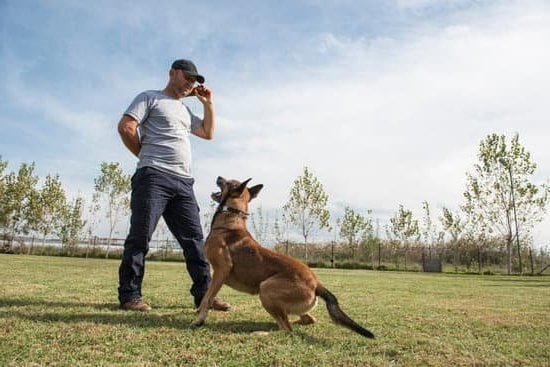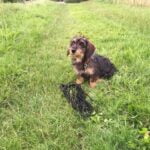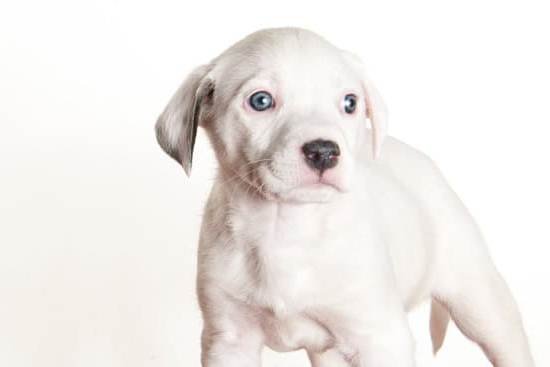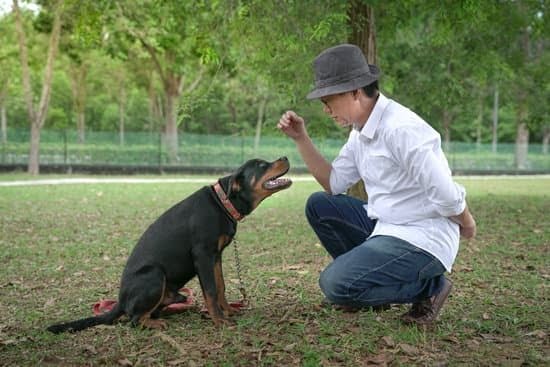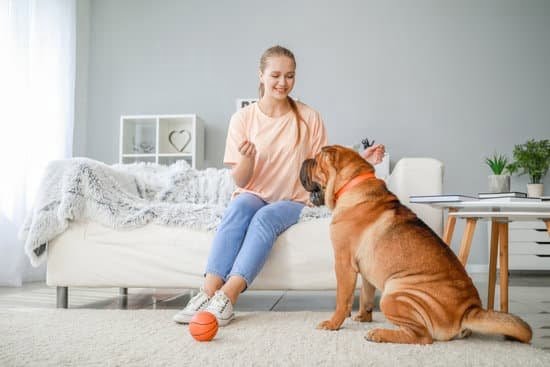It’s no secret that dogs love to jump, but when they constantly leap onto their owners and guests, it can become a nuisance and even potentially dangerous. This behavior is not only an exercise of excitement but also a way for dogs to assert dominance or seek attention. In order to have a well-behaved companion, training your dog to stop jumping is crucial.
Positive reinforcement has proven to be highly effective in shaping desired behavior in dogs. By understanding the reasons behind their jumping and implementing the right training techniques, you can establish boundaries and foster a calmer and safer environment for both you and your four-legged friend.
Dogs jump on people for various reasons, often stemming from their innate nature as social animals. As pack animals, dogs naturally seek attention and interaction with their human family members. Jumping becomes a means to get this attention quickly. Additionally, some dogs may engage in jumping behavior as a way to assert dominance over their owners or guests. Understanding these underlying motivations behind the behavior is essential in addressing it properly.
Training your dog to stop jumping holds importance beyond simple etiquette; it also prevents potential injuries to yourself and others. A dog’s exuberance can inadvertently lead to accidents such as knocking down children or elderly individuals. Moreover, some people may feel intimidated by an overly excited dog that jumps on them without invitation or provocation. By establishing clear boundaries through training, you create a safer environment where interactions with your dog can occur without fear of harm.
Positive reinforcement has emerged as one of the most effective methods when it comes to training dogs. Rather than using punishment or aversive techniques, this approach focuses on rewarding desirable behaviors while ignoring undesirable ones.
This article will delve into various positive reinforcement strategies that can be used specifically for teaching your dog not to jump on you or other people. With consistency, patience, and proper understanding of their behavior, you can effectively train your dog to keep all four paws on the ground.
The First Step
The behavior of a dog that jumps on you can be frustrating and even potentially dangerous. Therefore, it is important to train your dog to stop this behavior and establish boundaries. The first step in training a dog that jumps is to teach them the “off” command.
Teaching your dog the “off” command will help them understand that they should stay on the ground instead of jumping on you or other people. To start, use clear, consistent language when giving the command, such as saying “off” firmly. Pair this command with a visual cue, such as pointing or using hand signals, to reinforce what you want from your dog.
Consistency is key when teaching the “off” command. It is important to set clear expectations and reinforce them every time your dog tries to jump on you. Be patient and persistent during training sessions, maintaining a calm and assertive energy. This will help your dog understand that jumping is not acceptable behavior.
Here are some tips for establishing boundaries and teaching the “off” command:
- Ignore your dog’s jumping behavior by turning away or crossing your arms.
- Avoid scolding or punishing your dog, as this may confuse or frighten them.
- Instead, immediately give the “off” command and redirect their attention to another activity or toy.
- Reward your dog with treats, praise, or petting when they respond correctly to the “off” command.
By consistently reinforcing the “off” command and setting boundaries, you can effectively train your dog to stop jumping on you and other people.
| Tips for Establishing Boundaries and Teaching the “Off” Command |
|---|
| 1. Use clear language and visual cues when giving the “off” command. |
| 2. Be consistent in reinforcing the command and setting expectations. |
| 3. Maintain a calm and assertive energy during training sessions. |
| 4. Ignore jumping behavior and redirect your dog’s attention to another activity or toy. |
| 5. Reward your dog for responding correctly to the “off” command. |
Reinforcing Positive Behavior
Positive reinforcement is a key component in training a dog to stop jumping on you. By rewarding your dog for not jumping, you can reinforce the desired behavior and encourage them to continue behaving calmly and politely. Introducing the concept of positive reinforcement involves providing rewards such as treats or praise when your dog remains on the ground.
To effectively reinforce positive behavior, it’s important to understand the timing and types of rewards that work best for your dog. Some dogs may respond well to food treats, while others may be motivated by verbal praise or affection. Experiment with different rewards to see what resonates most with your dog.
One technique for reinforcing non-jumping behavior is capturing calmness. This involves being attentive to moments when your dog is not jumping and immediately rewarding them for this calm behavior. For example, if your dog approaches you without jumping, praise them and give them a treat or engage in playtime with their favorite toy.
Consistency is crucial when reinforcing positive behavior. It’s important to reward your dog every time they exhibit non-jumping behavior during training sessions and everyday interactions. Additionally, make sure that all family members and visitors are consistent in rewarding your dog for not jumping to prevent confusion.
Remember, positive reinforcement should always be paired with clear communication and clarity in expectations. Reinforcing non-jumping behavior will take time and patience, so it’s important to stay consistent and maintain a calm and assertive energy during training sessions.
By reinforcing positive behavior through rewards and consistent training techniques, you can teach your dog that staying on the ground is what gets them attention and affection. With time and effort, your dog will learn not to jump on you or others, resulting in more enjoyable interactions between both humans and canines alike.
Redirecting Energy
Training a dog that jumps on you requires more than just teaching them to stop the behavior. It is equally important to redirect their energy and find alternative outlets for their excitement. By providing appropriate channels for your dog’s energy, you can help them develop healthier behaviors and reduce their tendency to jump on people.
One effective way to channel your dog’s excitement is by providing them with interactive toys or mental stimulation. Interactive toys, such as treat-dispensing puzzles or tug toys, can engage your dog’s mind and physical abilities while keeping them occupied.
Mental stimulation activities, like scent games or training sessions, can also provide a productive outlet for their energy. Incorporating these activities into your daily routine will not only redirect your dog’s excitement but also strengthen the bond between you and your furry friend.
Daily exercise is another crucial aspect of redirecting your dog’s energy in a positive way. Dogs have a natural need for physical activity, and without proper exercise, they may become restless and more likely to exhibit unwanted behaviors like jumping.
Regular walks, playtime at the park, or engaging games of fetch are all excellent ways to burn off excess energy in a controlled environment. By providing adequate exercise, you can help release pent-up energy and reduce the urge for your dog to jump on you or others.
Incorporating training exercises into playtime can also be an effective strategy for redirecting energy and discouraging jumping behaviors. For example, practicing commands like “sit” or “stay” during play breaks can help establish self-control in your dog and reinforce good behavior.
Make sure to consistently reward calmness and non-jumping behavior throughout these training sessions. This combination of physical activity with mental stimulation and obedience training will give your dog a well-rounded outlet for their excitement while gradually diminishing their inclination to jump on you.
By redirecting your dog’s energy in a positive way through interactive toys, mental stimulation activities, daily exercise, and incorporating training exercises into playtime, you can effectively reduce their tendency to jump on people. Remember to be consistent in providing these outlets and reinforce desired behaviors with rewards. With time and patience, you can help your dog develop healthier behavior patterns and create a harmonious relationship between you and your four-legged companion.
Consistency is Key
Advocating for a consistent training routine to reinforce desired behavior
Consistency is key when it comes to training a dog that jumps on you. Dogs thrive in environments where routines are established and expectations are clear. By setting up a consistent training routine, you can effectively reinforce the desired behavior of your dog staying on the ground.
Start by identifying specific times during the day when your dog is more prone to jumping, such as when you come home from work or during mealtime. Use these moments as opportunities to practice the “off” command and reinforce the expectation of staying calm and grounded. Consistently practicing this routine will help your dog understand what is expected of them in these situations.
In addition, consistency should extend beyond just the timing of training sessions. It is important to ensure that everyone in your household understands and follows the same rules and techniques for addressing jumping behaviors. Inconsistencies or mixed signals can confuse your pet and hinder progress. By establishing a united front, you create an environment that reinforces consistency and helps your dog understand what is expected at all times.
Setting realistic expectations for the training process
Training a dog that jumps on you takes time and patience. It’s important to set realistic expectations from the start, understanding that each dog learns at their own pace. While some dogs may respond quickly to training methods, others may require more time and repetition.
It’s essential not to get discouraged if progress seems slow initially. Remember that every small victory is a step in the right direction. Celebrate even the smallest improvements in your dog’s behavior and acknowledge their efforts.
Keep in mind that dogs are individuals with unique temperaments and learning abilities. Some dogs may take longer than others to grasp concepts and change their behavior accordingly. Be patient with your furry friend, provide ample positive reinforcement, and trust that they will learn at their own pace.
Encouraging persistence and patience when faced with setbacks or relapses
It’s common for dogs to experience setbacks or relapses during the training process, especially when it comes to behaviors like jumping. Don’t be disheartened if your dog reverts to their old jumping habits occasionally – this is a normal part of the learning process.
When faced with setbacks, remain persistent and patient in your training efforts. Continue to consistently reinforce the “off” command and reward desired behavior. It can be helpful to revisit earlier training techniques if necessary or seek advice from a professional trainer.
Remember that training a dog is not an overnight process. Stay committed to the training routine you have established and maintain a positive mindset throughout. With time, consistency, and patience, your dog will learn to become calm and controlled instead of jumping on you or others.
Socialization
One crucial aspect of training a dog that jumps on you is teaching them proper greetings and interaction with both people and other animals. Socialization plays a vital role in preventing jumping behaviors and promoting good behavior overall. In this section, we will discuss the importance of socialization, provide guidance on teaching your dog to greet people calmly and politely, and share tips on exposing your dog to different environments and situations.
First and foremost, it is important to understand the significance of socialization in a dog’s life. Dogs are naturally pack animals and have an inherent need for social interaction. Proper socialization not only helps prevent behavioral issues like jumping but also contributes to a well-rounded, confident, and friendly dog.
When teaching your dog how to greet people calmly, it’s essential to set clear expectations right from the start. Begin by establishing rules about jumping during greetings. Consistency is key – ensure that everyone who interacts with your dog enforces these rules consistently.
To teach proper greeting behavior, start by asking family members or friends to assist you in training sessions. Begin with controlled environments where distractions are limited. Have the person approach your dog calmly without making eye contact or giving attention until they sit or remain still. Once the dog remains calm, reward them with treats or praises for displaying appropriate behavior.
In addition to greeting people calmly, your dog should also learn proper interaction with other dogs and animals. Dog parks or supervised playdates can be great opportunities for your furry friend to socialize safely with others. Start gradually by introducing them one-on-one to well-behaved dogs before progressing to larger groups.
Remember that every dog is unique, so take their individual personalities into account when exposing them to new situations or environments. Gradually increase the level of difficulty as they become more comfortable and confident in their interactions.
Overall, proper socialization plays a pivotal role in training a dog that jumps on you. Teaching your dog proper greetings and interaction ensures they can interact with humans and animals in a calm and polite manner. By incorporating these techniques into your training routine, you are setting your furry friend up for success and promoting positive behavior in all aspects of their lives.
| Training Techniques | Description |
|---|---|
| Setting Clear Expectations | Establish rules about jumping during greetings and ensure consistency in enforcing them. |
| Gradual Exposure to New Situations | Start with controlled environments before gradually introducing more challenging situations for your dog. |
| Reward-Based Training | Use treats or praises to reward your dog for displaying appropriate greeting behaviors. |
Training Tools and Techniques
The Role of Training Tools and Equipment
When training a dog that jumps on you, it can be helpful to utilize appropriate training tools and equipment. These tools can assist in reinforcing boundaries, redirecting energy, and promoting positive behavior. It is important to choose humane training methods and avoid aversive devices that may harm or cause undue distress to your dog.
One commonly used training tool is a no-pull harness, which can provide better control and prevent jumping by redirecting your dog’s attention towards the desired behavior. When choosing a no-pull harness, look for one that fits properly and does not restrict your dog’s movement or breathing.
Leashes are another essential training tool that can help in managing a dog’s jumping behavior. Utilizing a shorter leash during walks or when greeting visitors can help maintain control and prevent your dog from jumping up on people.
Additionally, there are various types of treats specifically designed for training purposes. These treats can serve as positive reinforcement when rewarding your dog for good behavior, such as staying calm and not jumping. It is important to choose treats that are healthy, easily digestible, and irresistible to your dog.
Choosing the Right Training Aids
When selecting training aids for a dog that jumps on you, it is vital to consider the individual needs of your dog and the specific behaviors you are trying to address. There are several factors to keep in mind when choosing the right tools:
- Size and Strength: Take into account your dog’s size and strength when selecting collars or harnesses. Larger dogs may require sturdier equipment with more control options.
- Sensitivity: Some dogs may be more sensitive than others, so it is important to choose equipment that will not cause them discomfort or distress. Look for soft materials or padded options if needed.
- Safety: Ensure that any training aids you use do not pose any risk to your dog’s well-being. Avoid equipment that could potentially harm or injure your dog, such as prong collars.
Remember, training tools and aids are just that – tools. They are meant to assist in the training process but should not be relied upon as the sole solution. It is essential to combine these tools with other training techniques and positive reinforcement strategies for an effective and holistic approach to addressing jumping behaviors in dogs.
Using Training Tools Wisely
When training a dog that jumps on you, it is important to remember that training tools should be used responsibly and ethically. Choose tools and aids that align with positive reinforcement methods and focus on promoting good behavior rather than punishing unwanted behavior.
By utilizing appropriate training tools, such as no-pull harnesses, leashes, and treats, you can provide your dog with the necessary guidance and support to overcome their jumping habits. However, it is crucial to always prioritize your dog’s safety, comfort, and overall well-being when using any training aid.
With consistent effort, patience, and positive reinforcement techniques paired with suitable training tools, you can train a dog that jumps on you effectively while building a stronger bond between you and your furry companion.
Seeking Professional Help
While many dog owners are able to effectively train their dogs on their own, there are some situations where seeking professional help is necessary. When it comes to dealing with a dog that jumps on you, enlisting the assistance of a trained dog trainer can provide invaluable guidance and support. Here are some key factors to consider when deciding whether or not to work with a professional:
- Lack of Progress: If you have been consistently implementing training techniques outlined in this article, but your dog’s jumping behavior persists or worsens, it may be time to seek professional help. A dog trainer can evaluate your specific situation and tailor a training plan to address the underlying cause of the jumping behavior.
- Safety Concerns: Jumping can sometimes become an aggressive behavior in certain dogs, especially if they escalate by nipping or biting. If you feel unsafe or unable to control your dog’s jumping behaviors on your own, consulting with a professional trainer is essential for both your safety and the well-being of your canine companion.
- Time Constraints: Training a dog requires time and commitment. If you find yourself lacking the time or energy needed for consistent training sessions, working with a dog trainer can alleviate some of that burden. With their expertise and structured training programs, trainers can expedite the training process and ensure progress is made even amidst busy schedules.
When searching for a reputable dog trainer, it’s important to consider their credentials and experience in dealing with behavioral issues such as jumping. Look for trainers who utilize positive reinforcement methods and avoid aversive techniques that may harm your dog’s wellbeing.
Remember, seeking professional help is not an admission of failure but rather an acknowledgment of one’s commitment towards resolving jumping behaviors in their dogs. A skilled trainer can provide valuable insights, alternative strategies tailored to your unique situation, and ongoing support throughout the training process.
Working together with a professional ensures that both you and your dog receive the guidance needed to address jumping behavior appropriately, leading to a more harmonious relationship between you and your furry companion.
Conclusion
Training a dog that jumps on you can be challenging, but with patience, consistency, and positive reinforcement, it is possible to achieve success. Throughout this article, we have discussed various techniques and strategies to address jumping behavior in dogs. By establishing boundaries, reinforcing positive behavior, redirecting energy, maintaining consistency, promoting socialization, using appropriate training tools, and seeking professional help when needed, you can effectively train your dog to stop jumping on you.
As you continue your training journey, it is important to celebrate the progress made by your dog. Each small victory should be acknowledged and rewarded. By doing so, you reinforce the desired behavior and motivate your dog to continue improving. Remember that training takes time and commitment. It is a process that requires patience and perseverance.
By investing time and effort into training a dog that jumps on you, you are not only creating a better-behaved companion but also fostering a stronger bond with your furry friend. The benefits of a well-trained dog extend beyond just eliminating jumping behaviors. Your dog will become more confident and balanced in various situations.
In conclusion, with the right approach and dedication from both you and your dog, it is entirely possible to train a dog that jumps on you. By implementing the techniques outlined in this article consistently and celebrating every step of progress along the way, you can successfully teach your furry friend appropriate greeting behavior.
Remember to be patient with your pet throughout the process as they learn new habits and adjust their behavior accordingly. Training a dog takes time but the rewards in having a well-behaved four-legged companion are immeasurable.
Frequently Asked Questions
How do you train a dog to not jump on you?
Training a dog to not jump on you involves consistency, positive reinforcement, and redirection. It is important to establish clear boundaries and consistently reinforce them. One approach is to ignore the dog when they jump up and instead reward them with attention, treats, or praise when all four paws are on the ground.
This teaches the dog that jumping does not lead to desired results while staying calm and well-behaved does. Another effective technique is redirection, where you provide an alternative behavior for the dog to engage in instead of jumping, such as sitting or offering a paw. Consistent training sessions combined with patience and positive reinforcement will help the dog understand that jumping is not acceptable behavior.
What to do with a dog that jumps on you?
When a dog jumps on you, it is important to respond appropriately and consistently to discourage this behavior. The first step is to avoid inadvertently rewarding the dog for jumping by withholding attention or eye contact when they do so. Instead, turn your back or step away from the dog without saying anything until they have all four paws on the ground again.
Once the dog is calm, you can offer praise or rewards for their good behavior. It is essential to remain consistent in this response and ensure that everyone interacting with the dog follows these guidelines as well.
Why does dog try to jump on me?
Dogs may try to jump on people for various reasons, such as seeking attention, excitement, or wanting physical contact. Jumping can be a natural instinct for dogs when they greet humans due to their eagerness to interact and show affection.
Additionally, some dogs may jump as a form of dominance display or due to anxiety or overexcitement in certain situations. Understanding why a dog tries to jump on you can be helpful in addressing the issue effectively through appropriate training techniques like redirection and consistent reinforcement of desired behaviors like sitting calmly during greetings.

Welcome to the blog! I am a professional dog trainer and have been working with dogs for many years. In this blog, I will be discussing various topics related to dog training, including tips, tricks, and advice. I hope you find this information helpful and informative. Thanks for reading!

